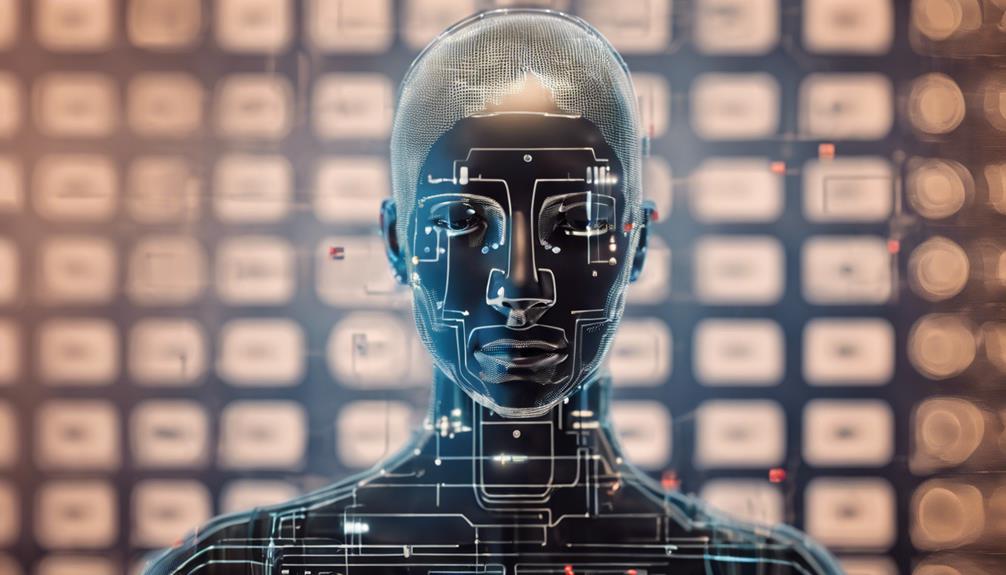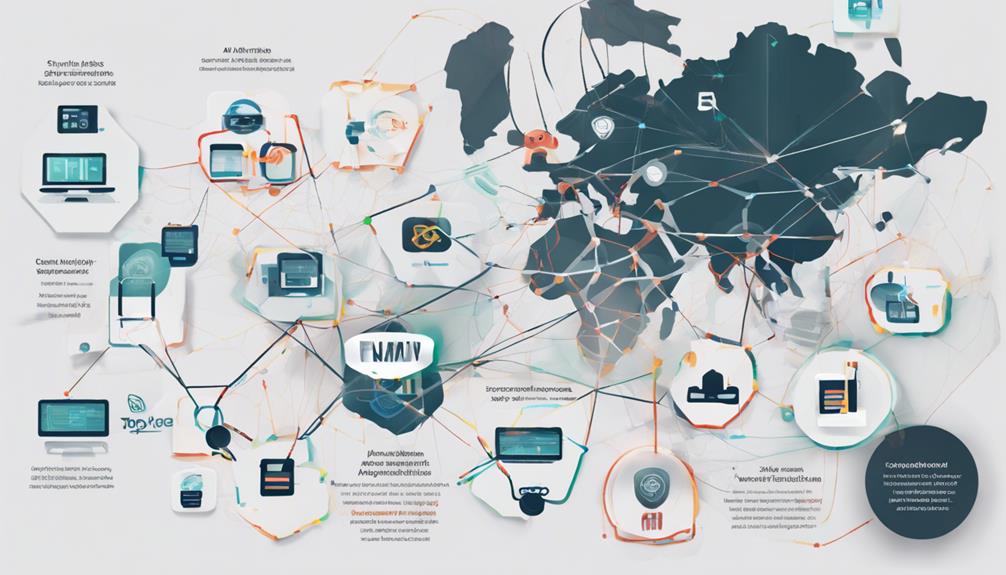In the domain of cybersecurity, AI excels at detecting threats with up to 92% accuracy, saving time during incidents, and bolstering vulnerability management by predicting and patching weaknesses promptly. AI's prowess extends to analyzing and thwarting malware attacks with an 80%-92% success rate and fortifying identities through dynamic risk-based privileges and authentication measures. These real-world applications showcase AI's power in fortifying digital defenses.
Key Takeaways
- AI detects unusual user behavior and new attacks, adapting to evolving threats.
- Automated incident response saves time, minimizes impact, and enhances collaboration.
- AI technology enhances vulnerability scanning, prioritizes patches, and predicts future weaknesses.
- AI efficiently detects and analyzes malware, providing a shield against cybersecurity breaches.
- AI in identity management adjusts user privileges dynamically, enforces authentication, and ensures secure sessions.
Threat Detection and Prevention
AI's prowess in threat identification is exemplified through its ability to analyze extensive data sources, detect unusual user behavior patterns, and indicate potential cyberattacks. Machine Learning algorithms enhance threat detection accuracy by identifying new types of attacks and adapting to evolving threats. These AI-powered cybersecurity systems boast an impressive efficiency rate of 80% to 92% in detecting malware and phishing attacks, greatly bolstering security measures.
Behavioral analytics, a key component of AI-driven threat detection, enables the distinction between normal and suspicious user activities, laying the groundwork for proactive threat prevention. By employing behavior analytics, cybersecurity systems can swiftly identify anomalies and potential security breaches before they escalate, thereby minimizing the risk of damage.
Moreover, AI-driven endpoint protection systems establish baselines of normal behavior and detect deviations in real-time, providing a robust layer of defense against cyber threats. Through automated threat detection mechanisms, organizations can fortify their incident response capabilities, ensuring a swift and effective response to any potential security breach.
Automated Incident Response

The implementation of automated incident response systems powered by AI has revolutionized the efficiency and effectiveness of handling security incidents in cybersecurity operations. These AI-driven solutions automate incident response tasks, greatly improving response times and minimizing the impact of security breaches. Popular tools like Microsoft Security Copilot and Darktrace use AI to streamline incident response workflows and enhance collaboration among security teams. By leveraging AI-powered automated incident response, organizations can save time during security incidents, enrich investigation information instantly, and maintain a continuous feedback loop for detecting and responding to security incidents effectively.
| Benefits of AI in Automated Incident Response | ||
|---|---|---|
| Saves time during security incidents | Minimizes the impact of security breaches | Enhances collaboration among security teams |
| Enriches investigation information instantly | Improves response times | Streamlines incident response workflows |
Vulnerability Scanning and Management

Automated vulnerability scanning and management processes leverage AI technology to enhance the identification and prioritization of system weaknesses. By utilizing machine learning algorithms, AI can efficiently prioritize vulnerabilities for patching based on their severity and potential impact on the system.
Predictive analysis further strengthens the defense mechanism by preemptively identifying future vulnerabilities before malicious actors can exploit them.
Through automated vulnerability assessment, AI guarantees that critical patches are deployed promptly to secure vulnerable components, thereby reducing the window of exploitation for attackers. This proactive approach not only minimizes the time for potential breaches but also streamlines the vulnerability management process.
Malware Analysis and Detection

Enhancing cybersecurity measures extends beyond vulnerability scanning and management to encompass the crucial domain of malware analysis and detection, where AI technologies exhibit remarkable efficiency and accuracy. AI-powered systems boast an impressive 80% to 92% efficiency rate in detecting and analyzing malicious activities, including ransomware attacks that hold data hostage until a ransom is paid.
Techniques such as computer vision are leveraged within AI frameworks to guarantee accurate and efficient detection of evolving cyber threats. In 2019, a staggering 93.67% of observed malware demonstrated the ability to adapt by modifying its source code, underscoring the need for advanced detection mechanisms.
Phishing attacks, a prevalent form of malware, rely on deceptive tactics like sending malicious links to unsuspecting users to harvest sensitive information. By employing AI-driven solutions in malware analysis and detection, organizations can stay ahead of these malicious activities, providing a shield against potential cybersecurity breaches.
Identity and Access Management

How can AI revolutionize the domain of identity and access management in cybersecurity?
AI plays a vital role in enhancing security measures by analyzing biometric data, behavior patterns, and contextual information to strengthen access control. Machine learning algorithms enable the detection of suspicious access patterns, dynamically adjusting user privileges based on continuous risk assessments, thereby fortifying security protocols.
Through the utilization of AI-driven access control systems, organizations can automate access decisions, enforce multi-factor authentication, and provide continuous authentication for secure user sessions. Behavioral biometrics, powered by AI, offer a personalized user experience while ensuring the security of sessions by providing continuous authentication to prevent unauthorized access.
Leading tools like Okta and Ping Identity leverage AI to enhance identity management processes, offering advanced security features and personalized user experiences. By integrating AI into identity and access management practices, organizations can guarantee robust security measures while delivering seamless and secure user interactions.
Frequently Asked Questions
What Is a Real Life Example of AI in Cyber Security?
A real-life example of AI in cybersecurity includes the utilization of machine learning algorithms to detect and respond to cyber threats in real-time, enhancing the overall security posture of organizations by proactively identifying and mitigating potential risks.
What Is a Common Application of AI in Cybersecurity?
An essential application of AI in cybersecurity involves enhancing threat detection and response capabilities through advanced data analysis and pattern recognition. This enables security teams to efficiently identify anomalies and swiftly mitigate potential security breaches.
How Can AI Be Used in Cyber Security?
In cybersecurity, AI brings immense value by enhancing threat detection, automating tasks, predicting attacks, and improving user authentication. By leveraging machine learning algorithms, AI analyzes data to identify anomalies, prioritizing vulnerabilities, and proactively safeguarding organizations from cyber threats.
What Is an Example of Real World Application of Ai?
An example of a real-world application of AI involves leveraging advanced algorithms to analyze vast datasets in real-time, identifying patterns and anomalies to detect potential cyber threats swiftly and proactively enhance overall security measures.
Conclusion
To sum up, the integration of AI in cybersecurity has revolutionized the way we protect our digital assets. From threat detection and prevention to automated incident response, AI technology offers a powerful defense against cyber threats.
By utilizing the latest advancements in machine learning and data analysis, organizations can enhance their security posture and mitigate risks effectively.
How will you harness the power of AI to safeguard your digital environment?









